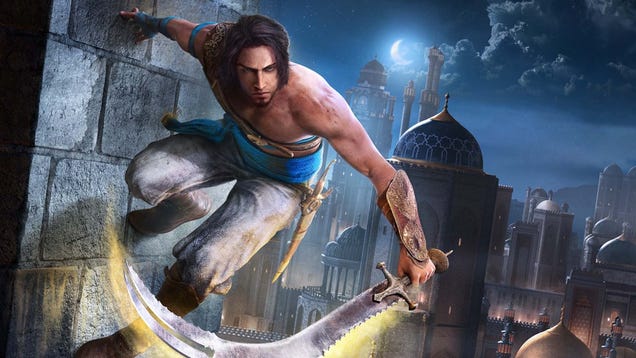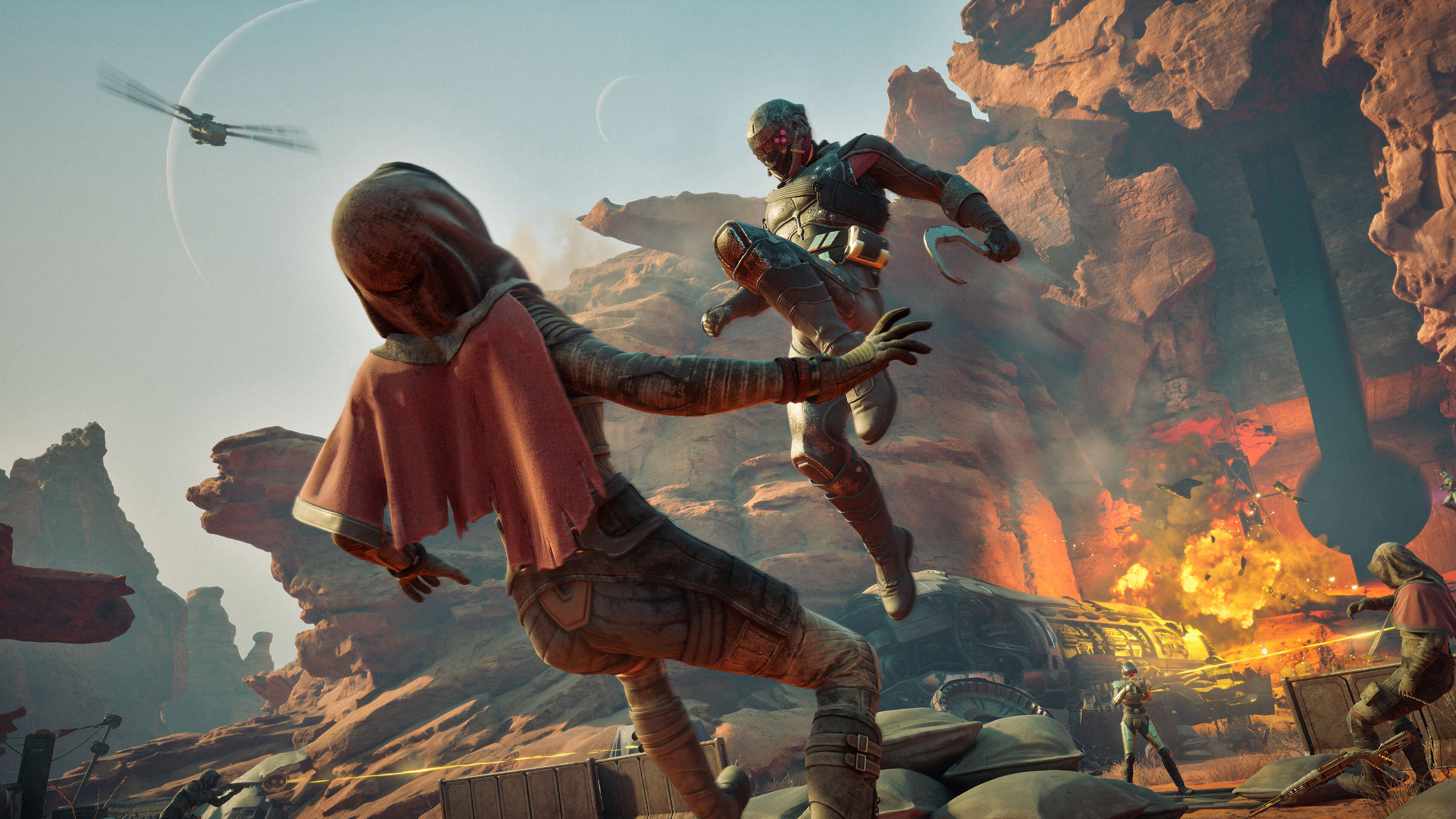
There’s a lot to be said about unapologetically single-player games like Atomic Heart: its entire focus is on creating an intricate world for us to explore and discover for ourselves. An eye-catching blend of super-powered shooting and first-person puzzling, this is a lengthy, tough, and terrific-looking shooter that has us bathing in the blood and gears of elaborately designed enemies both biological and robotic and dispatching them with an impressive set of combat options. Granted, it’s not as clever as it thinks it is when dealing with melee combat or its typical fetch quests, and the story doesn’t quite stick its landing, but the journey from point A to point B is a sight to behold.
Atomic Heart is an alternate-history shooter cut from the same cloth as BioShock and MachineGames’ Wolfenstein series. It’s a kind of retrofuturistic romp back to an imagined past perverted by ridiculously advanced technology; a world where science has made the supernatural a reality and robots are now running rife. These are far from the only shooters Atomic Heart is unafraid to crib from, either. Half-Life and the puzzle-solving of Portal are also clear inspirations, and there’s been an attempted sprinkling of Arkane’s successful brand of first-person stealth, too.
It’s a kind of retrofuturistic romp back to an imagined past perverted by ridiculously advanced technology.
However, it’d be unfair to call Atomic Heart wholly derivative despite such recognisable building blocks. Certainly the idea of a peaceful utopia torn to pieces thanks to technology turning on its ambitious masters is nothing new, but developer Mundfish has still assembled its vision in a confident and compelling way – and the art team here well and truly understood the assignment.
Mechanical Mystery Tour
The most remarkable element here is the superb visual design, especially the look of these well-crafted enemies. Its range of robots is particularly strong, from its sleek and sinister moustachioed terminators that charge at us without ever averting their gaze to its pot-bellied parking meters with mouth tubes that make them look like they’re sucking at the drawstring on an invisible jacket. Its featureless ballerina bots and spindly-legged battle balls are equally memorable – the latter of which are probably best described as scaled-down, Eastern Bloc knock-offs of those things that couldn’t kill Mr. Incredible. There’s even one that looks like Baymax cosplaying as a tank.
Atomic Heart’s outstanding aesthetic also extends to its large range of partially ruined labs, facilities, and transportation hubs – each filled with long, snaking globules of the liquid polymer that powers the advancements of this fantastical 1950s. That said, there is a distinct feeling of ‘look, don’t touch’ in these places (there’s definitely a lack of destructibility; balloons immune to axe swings are probably the worst offenders) but the level of detail overall is strikingly good.
There are some especially tiny touches in Atomic Heart that smack of a great deal of consideration, like the way there are different reload animations for unspent magazines compared to empty ones – the latter of which are flicked away while the former are grasped by the same hand sliding a fresh one in. Watching them play out is a pleasure, which is why it was a bit annoying that my HUD was sometimes cluttered up with pick-up notifications and health bars for minibosses no longer in the area that froze onscreen until I reloaded from a recent save. I’ve also experienced some uneven quality when it comes to graphical glitches as I’ve played on Xbox Series X. The worst is a terrible strobing effect on some fast-moving robots running circuits around a large room, but fortunately it seems mostly isolated to these bot types. I’ve had no such problems with similarly nimble (and often much larger) bosses.
Atomic Heart is, naturally, all tinted with the Soviet-era iconography you’d probably expect from a land tucked away deep behind the Iron Curtain in the mid-1950s, and admittedly the lens through which you may view all this Soviet symbolism is a little different today in 2023 than it was upon its announcement and first reveal back in 2018. Of course, having grown up geographically isolated and politically irrelevant in the southern hemisphere – largely detached from Cold War concerns and raised on Bond movies, Stripes, and Rocky IV – my read on such an overtly Russian backdrop is guaranteed to be markedly different to someone with roots in Eastern Europe. For its part, however, the background does largely fade away as Atomic Heart peels back the layers of its false utopia. At this stage, Facility 3826 and the countryside of rural Russia isn’t much different to the likes of BioShock’s Rapture itself. That is, a place more or less cut off from the outside world and where something has gone deeply, deeply wrong.
Exploring exactly what’s gone wrong is the job of our character, special forces veteran Major Sergey Nechaev, or P-3 as he’s dubbed throughout. The foul-mouthed and amnestic P-3 is admittedly a bit of a relic of games gone by – and his default English-language voiceover doesn’t exactly do him a lot of favours. He comes off as the cookie-cutter American lead of every second shooter ever made.
The foul-mouthed and amnestic P-3 is admittedly a bit of a relic of games gone by.
However, it’s the script that really does him a greater disservice. While I’ll happily admit swearing is virtually my second language, P-3 spews it with the gusto of a teenage boy testing every curse word he’s recently learned twice a sentence. It’s a little exhausting, and the presence of many modern turns of phrase don’t exactly help keep the overall experience seated in the 1950s.
Of course, perhaps I’m being hypocritical in demanding consistency there, because the regularly ruthless soundtrack packed with headbangers courtesy of Doom and Wolfenstein composer Mick Gordon isn’t exactly a sonic journey back to the days of doo-wop, either – and yet the music is pitch perfect as far as I’m concerned. At any rate, there is a Russian-language/English subtitle option for purists, but I would’ve simply preferred an English script that was more tempered for the setting and era.
There are well over 20-odd hours of play here in the main story thread alone, with many more available in the side objectives – some of which border on crucial if you actually want the best weapons. Some of that is padding but it’s a good length overall, and nicely inside that not-too-short, not-too-long Goldilocks zone for a great solo shooter. There are also two endings you can get based on just one choice you make in the finale, although after seeing both I found the first anticlimactic and don’t think the second was worth the reload.
All You Need is Glove
However, while P-3 is disappointingly threadbare as a character, he’s nonetheless very capable and entertaining to play as – largely thanks to his partner, Charles, who is a talking glove. Okay, that’s a bit reductive – rather, Charles is basically an intelligent system embedded in P-3 who is capable of granting him seemingly supernatural abilities, manifested by a set of small, squid-like tentacles that extend from a glove on P-3’s left hand. This not only includes activating an X-ray-style view of your surroundings and tossing certain small objects à la Half-Life 2’s iconic gravity gun, but also the ability to fire bolts of electricity or ice, levitate enemies into the air to shoot or slam into the ground, or even summon a temporary shield.
Akin to BioShock’s Plasmids, these abilities add an important layer of more interesting combat on top of Atomic Heart’s otherwise fairly typical blasting and slightly clumsy melee combat. There’s a great sense of weight when beaning a bot in the brainpan with an axe – and the gouges that appear across their bodies in real-time is a great touch – but I found the weapon swinging too slow and frustrating when swarmed by too many enemies simultaneously.
The juggling act of defeating dense swarms of robots as well as the blender-sized hovering repair bots that continually swoop in to magically resurrect them gets a bit wearisome at times, especially above ground. Atomic Heart’s linear, underground sequences are linked by a decent-sized slab of open world where we’re free to explore and fight wherever we wish, and this zone is initially a nice antidote to the more corralled corridor segments that progress the story or reward us with useful upgrades. However, with their long line-of-sight and overwhelming numbers, I often found myself running or driving away from fights rather than diving in or trying to get the upper hand via stealth before attacking – because they’re not that much fun to fight over and over. There is a way to fry all enemies within a zone for a while if you’re patient, and the robot hordes do become a little less intimidating as P-3 and his arsenal grow stronger throughout the story, but that’s a process that takes some time.
Unlocking and upgrading these abilities requires a steady supply of resources, which the levels and defeated enemies are generally chock full of, even if collecting them can become a bit of a chore. Atomic Heart is smart to keep this process fast by allowing us to extend out a hand and suck up reams of resources like an industrial shop vac, but it still becomes a little tedious having to ransack the same sets of desks and cabinets arranged slightly differently in a hundred-or-so different rooms.
The main character being annoyed for the same reason I am isn’t cute, it’s a tone deaf non-apology for weak game design.
Tedious, too, is Atomic Heart’s overly ambitious attempt to weasel its way out of accountability for leaning on some extremely hackneyed fetch quests. Having the main character cynically gripe and complain about collecting four canisters for a bafflingly unintuitive door-locking mechanism that would never get past any sensible architectural committee isn’t a free pass to proceed with it. The main character being annoyed for the same reason I am isn’t cute, it’s a tone deaf non-apology for weak game design.
It’s a shame that some better context wasn’t baked around these occasional fetch quests because Atomic Heart’s underground chambers feel like a ripe opportunity and are largely great otherwise: eerie, deadly, and mostly devoid of life – unless you count the mutant freaks with skulls shattered into fanged, floral arrangements or the dead bodies that communicate via the confused ramblings of their fading brain implants. It does rely too heavily on repeating the same handful of door lock minigames that serve no real purpose other than to arbitrarily slow your progression from room to room, but I do like the bespoke platforming puzzle chambers and one-off brainteasers – especially the clever visual puzzle you’ll encounter late during your trip to an ornate theatre full of robotic performers.






